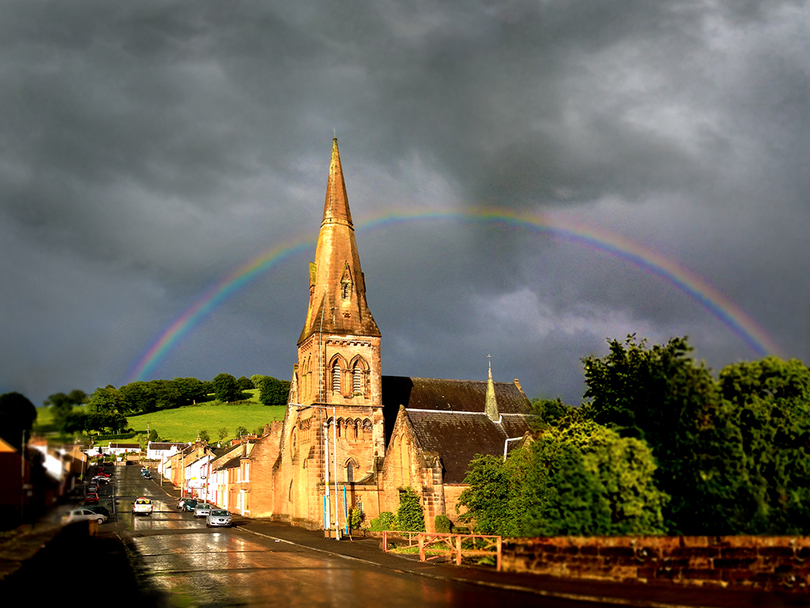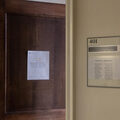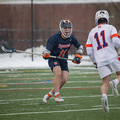The destruction varied. In Sherwood Crescent, where all the Lockerbie residents were killed, wreckage blasted a 26-foot deep crater in the ground. It destroyed some bungalows and set fire to others, yet some buildings suffered as little as one cracked window. The parents of one man whom Dorrance went to high school with still live in the same, unchanged bungalow today, Dorrance said.
Only different brickwork, an updated main road and a memorial for the Sherwood Crescent victims hint at more.
Residents say people from the United States and Scotland grieve differently: those from the U.S. do so publicly and the Scottish more privately.
“We don’t talk about things like that. The town … I have to warn people that come here, it’s not a disaster theme park. It’s not as if everyone is in on the plot, and we all know it, inside out,” Dorrance said.
For the month following the crash, Dorrance worked night shifts in Lockerbie. He left in January 1989 to go back to his regular duties in another town. He separated himself from his memories of the plane crash and only began to revisit them when his daughter, Claire, was chosen to study at Syracuse University as a Lockerbie Scholar. His son, Andrew, is a current Lockerbie Scholar.
“The sheer scale of it was new to everybody. The guys who were nearly retired had never seen anything like it, never mind someone who was just fresh to it, and in a way there was a bit of an advantage of being an 18-year-old because you’re young, free and single,” Dorrance said. “If I was to go into the same situation now, as a married father with two kids who had been the same age as many of the students, I think I would find it harder to deal with emotionally.”
I have to warn people that come here, it’s not a disaster theme park.Colin Dorrance
Much of the physical landscape untouched by damage remains virtually unchanged. The High Street is still mostly the same as it was in the 1980s, Dorrance said. Lockerbie’s agricultural industry is still prolific. Buildings like the town hall and ice rink, which were temporarily used as mortuaries, were quietly converted back into their original purposes.
Many of the residents who lived in Lockerbie at the time of the disaster have moved away or died of old age, Gair said. New people have arrived who haven’t heard of the crash, and many were born after 1988.
David Wilson, treasurer of the Dryfesdale Lodge Visitors’ Center Trust and resident of Lockerbie since 1966, said people aren’t necessarily passing down their memories of the crash.
“There is something in the Scottish culture, that you dust yourself down and you know the sun is going to rise whether you want it to or not, so you might as well get on with it,” Wilson said. “I think there was a general sort of stiffening of the spine.”
But the tragedy remains in the collective memory of the town, its place solidified by years of visits from SU students and alumni, professors and representatives. Dorrance has hosted about 40 tours, including one for Chancellor Kent Syverud and Ruth Chen, professor of practice in the College of Engineering and Computer Science, this past summer.
Lawrence Mason, a photography professor in the S.I. Newhouse School of Public Communications, took his first trip to Lockerbie in 1996. Mason taught eight of the SU students killed in the crash and wanted to pay his respects.
There is something in the Scottish culture, that you dust yourself down and you know the sun is going to rise whether you want it to or not, so you might as well get on with it. I think there was a general sort of stiffening of the spine.David Wilson, treasurer of the Dryfesdale Lodge Visitors’ Center Trust and resident of Lockerbie since 1966
He had seen the now-famous image of the nosecone wreckage in the fields at Tundergarth Church. Yet, when he went to visit, he saw a “startling, beautiful” site: vibrant green grassy pastures, white sheep peacefully grazing.
It had been raining all day, but suddenly the clouds opened, the sun shone and a rainbow appeared.
Mason snapped a photo, and at the same moment saw a vision in his mind of two of his former students he knew best: Alexia Tsairis and Julianne Kelly. Lawrence said he was shocked not to have seen them but to have seen them smiling. Later, Mason learned that both Tsairis and Kelly were found in Tundergarth.
It was this experience that prompted him to co-write “Looking for Lockerbie” with Melissa Chessher, chair of the magazine department and director of the magazine, newspaper and online journalism graduate program in Newhouse, about the town beyond the plane crash. Mason took 15 trips to Lockerbie, while Chessher lived in Lockerbie for close to six months with her daughter. The two brought multiple groups of students to Lockerbie, photographing and writing about the residents.
Chessher remembers watching the high school cafeteria serve haggis, a savory Scottish sausage, for lunch. She listened to Lockerbians bicker about the English and Irish. She watched a sheep-herding competition for dogs with her daughter. She recalled the Scots’ devotion to ironing.
“It is a place filled with characters,” Chessher said. “I mean it is your prototypical small town.”
The book was supposed to show a side of Lockerbie not shown in the media. In the immediate aftermath, reporters had swarmed the town. The intrusion on lives and properties traumatized Lockerbians and closed residents off to reporters, something that persists even now, Dorrance said.







